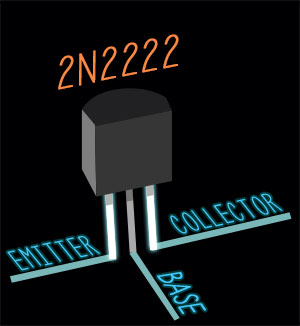

Used in Rectifier Circuits & DC Inverters.These transistors are used in Motor drive circuits like VFD or variable frequency drives.Used to switch several loads simultaneously.It is typically used in automation & embedded projects.Because of its fast response time, it can be used for pulse width modulation.It is used for PWM due to its quick response.This transistor can be used as a switch for automatically switch ON/OFF any appliances.This kind of transistor is mainly used for amplifying current.So, the 2N2222 transistor is the best choice for switching high current loads.As compared to the normal NPN BC547 transistor, the 2N2222 is extremely similar, but 2N2222 allows 800mA of collector current & also 652mW of power dissipation which can be utilized for driving larger loads as compared toBC547.The applications of the 2N2222A transistor include the following. It does not function efficiently like a relay or electrical, mechanical switches.It is extremely hard to replace with new ones by unsoldering.Faults cannot be found easily due to small size.The main disadvantages of using the 2N2222A transistor include the following. So this capability will make the device ideal in the applications of linear amplifiers.This transistor switches the load current with 800 mA through it, which is high as compared to others.It is capable of handling fairly high magnitude currents as compared to other similar transistors.In electronic circuits, most of the switching applications can be done by using this transistor.This is the most commonly used type of transistor.The main advantages of using the 2N2222 transistor include the following. Note that the motor here draws about 500mA from the 12V power source, since the 2N2222 has collector current rating upto 800mA this circuit is possible had it been a BC547 the transistor should have been burnt. I have used a base voltage of 5V and a value of 1K as current limiting resistor.

In actual circuit modifications might be required. To make things simple I have shown a simplified circuit to make a transistor as switch. The value for this resistor can be calculated using the formula: RB = VBE / IB. As the name suggests this resistor will limit the current flowing through the transistor to prevent it from damaging. However one important thing to notice is the Base resistor a.k.a current limiting resistor. This transistor will make it forward biased and thus closes the connection between collector and emitter. The Base-Emitter voltage of this transistor is 6V so you just have to supply this voltage across the base and emitter of the transistor to induce a base current into the transistor. This transistor like all can be used either as a switch or as an amplifier. The followings are2N2222A Symbol, Footprint, and 3D Model. Pin3 (Emitter): The emitter pin is the third pin of the transistor & it is used to drain out the complete current of the transistor.ĢN2907(PNP), 2N3904(PNP), 2N3906 (PNP), BC637, S9014, BC148, 2N4403, MPS2222, PN2222, KN2222, KTN2222.The main function of this pin is to control the current from emitter to base. Pin2 (Base): The base pin is a control pin & it is a second pin of the transistor.The main function of this pin is to provide transistor current toward the o/p load. Pin1 (Collector): This is the first pin of the transistor & it is an o/p pin.This transistor includes three pins & its each pin functionality is discussed below. The pin configuration of the 2N2222A transistor is shown below. Continuous Collector current (IC) is 800mA.Video: 2N2222 NPN Transistor as a switch - Arduino example with LED Flash This blog will introduce 2N2222A systematically from its features, pinout to its specifications, applications, also including 2N2222A datasheet and so much more. When base current is removed the transistor becomes fully off, this stage is called as the Cut-off Region and the Base Emitter voltage could be around 660 mV. This stage is called Saturation Region and the typical voltage allowed across the Collector-Emitter (VCE) or Base-Emitter (VBE) could be 200 and 900 mV respectively. When this transistor is fully biased then it can allow a maximum of 800mA to flow across the collector and emitter. To bias a transistor we have to supply current to base pin, this current (IB) should be limited to 5mA. The maximum amount of current that could flow through the Collector pin is 800mA, hence we cannot connect loads that consume more than 800mA using this transistor. 2N2222A has a gain value of 110 to 800, this value determines the amplification capacity of the transistor.

2N2222A is a NPN transistor hence the collector and emitter will be left open (Reverse biased) when the base pin is held at ground and will be closed (Forward biased) when a signal is provided to base pin.


 0 kommentar(er)
0 kommentar(er)
